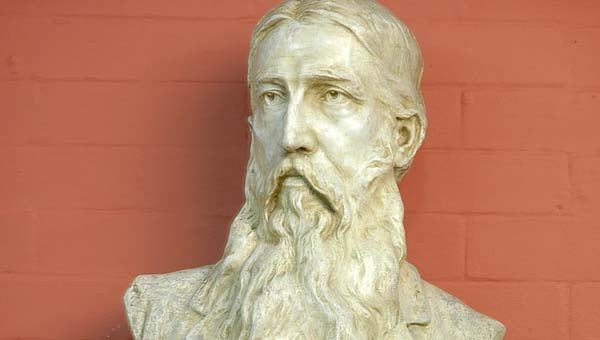Lanier Library named for young poet
Published 10:09 am Thursday, February 12, 2015

Today the Lanier Library helps to preserve the name of Georgia’s most famous poet. A
bust of Lanier displayed in an alcove is a plaster copy of the bronze original at Johns
Hopkins. It was donated by Lanier’s daughter-in-law, Mrs. Charles Lanier. (Photo submitted by Gina Malone)
In 1881, when he came to Lynn, poet Sidney Lanier was seeking respite from the tuberculosis he contracted as a Confederate soldier in a Virginia prison camp. He settled first at what would later be Mimosa Inn, and then was invited to stay at the nearby Wilcox house where he would spend the last two months of his life. Today, although the house is privately owned, a historical marker by Hwy. 108 reminds passersby of the home’s place in literary history.
His untimely death at 39 deprived Lanier of a more substantial body of work, but, perhaps because he was one of the most famous writers connected with the area at the time, it was his name that hopeful organizers of Tryon’s library chose when they formed the Lanier Club in 1890.
His wife, Mary, had stayed on in Tryon after his death, and lived on Lanier Street with two of her sons, Robert and Sidney. Just across the street was The Laurels, the boardinghouse where the first library club meeting was held. One of the ladies at that meeting, Lily Wilcox – of the family that owned the house where Lanier died – was selected to approach Mrs. Lanier about the use of her husband’s name.
Mrs. Lanier, early club notes state, was pleased by the suggestion and offered two volumes of her husband’s poems as the first books for the library. Though no longer circulated, those volumes are still part of the library’s collection today. One, a plain green clothbound book, Poems, has a newspaper clipping of Elia W. Peattie’s poem, “Lanier in the Valley,” pasted on the flyleaf. Peattie, literary critic for the Chicago Tribune, had a home in Tryon and was an active president of Lanier Library in the 1920s.
During his short lifetime, Lanier wrote many poems – “The Marshes of Glynn” being his most well-known – as well as a Civil War novel, “Tiger-Lilies,” and critical works, including “The Science of English Verse.”
Among the library’s many works of Lanier’s are “The Boy’s King Arthur” – a popular book in his lifetime – and biographies and letters of the poet. (An interesting literary tidbit is that he and playwright Tennessee (Thomas Lanier) Williams share a common ancestor.)
Not one to bow to sickness, it is said that, a few days before his death, he sent to Johns Hopkins University, where he had taught literature, asking for the loan of scientific equipment to study “the no-frost belt on the side of Tryon Mountain.”
Today the Lanier Library helps to preserve the name of Georgia’s most famous poet. A bust of Lanier displayed in an alcove is a plaster copy of the bronze original at Johns Hopkins. It was donated by Lanier’s daughter-in-law, Mrs. Charles Lanier.
A later gift to the library was an oil painting, Sidney Lanier’s Home in Lynn, Southern Poet, by Edward Ryerson. A special case in the library displays books by and about Lanier as well as a photograph of Mary Lanier with children and grandchildren, a sketch of the Lanier Oak Tree in Georgia and a copy, handwritten by Mary, of one of Lanier’s letters.
In 2009, the library began sponsoring the Sidney Lanier Poetry Competition with prizes for adult and high school poets from the Carolinas and, recently, Georgia as well. Beginning last year, the competition’s awards ceremony became the ending event for the Lanier Library Poetry Festival held the last weekend in April.
Next week follow the route of the traveling bookcase in the library’s early days until it found its home in the building at the corner of Melrose and Chestnut streets.
-By Gina Malone





